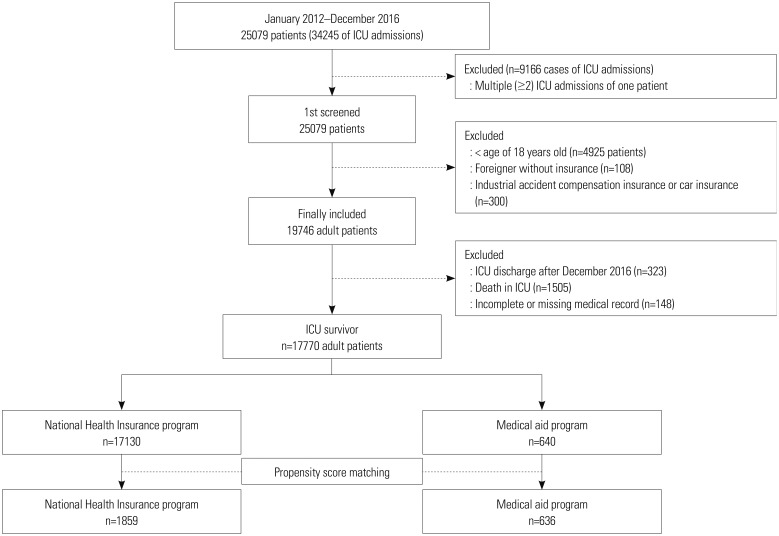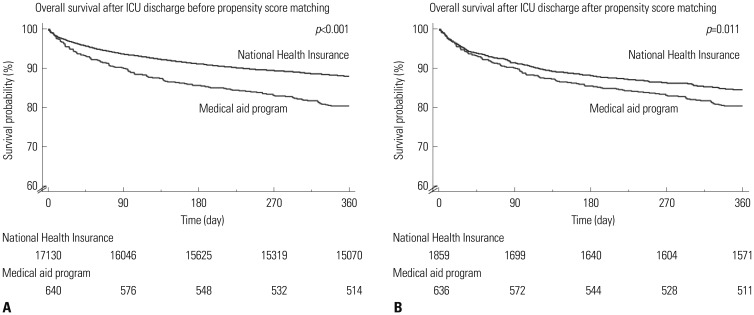Yonsei Med J.
2019 Oct;60(10):976-983. 10.3349/ymj.2019.60.10.976.
Impacts of Financial Coverage on Long-Term Outcome of Intensive Care Unit Survivors in South Korea
- Affiliations
-
- 1Department of Emergency Medicine, Hallym University Sacred Heart Hospital, Anyang, Korea.
- 2Department of Anesthesiology and Pain Medicine, Seoul National University Bundang Hospital, Seongnam, Korea. airohtak@hotmail.com
- KMID: 2459151
- DOI: http://doi.org/10.3349/ymj.2019.60.10.976
Abstract
- PURPOSE
The objective of this study was to investigate whether financial coverage by the national insurance system for patients with lower economic conditions can improve their 1-year mortality after intensive care unit (ICU) discharge.
MATERIALS AND METHODS
This study, conducted in a single tertiary hospital, used a retrospective cohort design to investigate discharged ICU survivors between January 2012 and December 2016. ICU survivors were classified into two groups according to the National Health Insurance (NHI) system in Korea: medical aid program (MAP) group, including people who have difficulty paying their insurance premium or receive medical aid from the government due to a poor economic status; and NHI group consisting of people who receive government subsidy for approximately 2/3 of their medical expenses.
RESULTS
After propensity score (PS) matching, a total of 2495 ICU survivors (1859 in NHI group and 636 in MAP group) were included in the analysis. Stratified Cox regression analysis of PS-matched cohorts showed that 1-year mortality was 1.31-fold higher in MAP group than in NHI group (hazard ratio: 1.31, 95% confidence interval, 1.06 to 1.61; p=0.012). According to Kaplan-Meir estimation, MAP group also showed significantly poorer survival probability than NHI group after PS matching (p=0.011).
CONCLUSION
This study showed that 1-year mortality was higher in ICU survivors with low economic status, even if financial coverage was provided by the government. Our result suggests the necessity of a more nuanced and multifaceted approach to policy for ICU survivors with low economic status.
Keyword
MeSH Terms
Figure
Cited by 1 articles
-
The effect of socioeconomic status, insurance status, and insurance coverage benefits on mortality in critically ill patients admitted to the intensive care unit
Moo Suk Park
Acute Crit Care. 2022;37(1):118-119. doi: 10.4266/acc.2022.00129.
Reference
-
1. Brinkman S, de Jonge E, Abu-Hanna A, Arbous MS, de Lange DW, de Keizer NF. Mortality after hospital discharge in ICU patients. Crit Care Med. 2013; 41:1229–1236. PMID: 23591209.
Article2. Goldhill DR, Sumner A. Outcome of intensive care patients in a group of British intensive care units. Crit Care Med. 1998; 26:1337–1345. PMID: 9710091.
Article3. Moreno R, Morais P. Outcome prediction in intensive care: results of a prospective, multicentre, Portuguese study. Intensive Care Med. 1997; 23:177–186. PMID: 9069003.
Article4. Winters BD, Eberlein M, Leung J, Needham DM, Pronovost PJ, Sevransky JE. Long-term mortality and quality of life in sepsis: a systematic review. Crit Care Med. 2010; 38:1276–1283. PMID: 20308885.
Article5. Sukantarat KT, Williamson RC, Brett SJ. Psychological assessment of ICU survivors: a comparison between the Hospital Anxiety and Depression scale and the Depression, Anxiety and Stress scale. Anaesthesia. 2007; 62:239–243. PMID: 17300300.
Article6. Schofield-Robinson OJ, Lewis SR, Smith AF, McPeake J, Alderson P. Follow-up services for improving long-term outcomes in intensive care unit (ICU) survivors. Cochrane Database Syst Rev. 2018; 11:CD012701. PMID: 30388297.
Article7. Gayat E, Cariou A, Deye N, Vieillard-Baron A, Jaber S, Damoisel C, et al. Determinants of long-term outcome in ICU survivors: results from the FROG-ICU study. Crit Care. 2018; 22:8. PMID: 29347987.
Article8. Lone NI, Gillies MA, Haddow C, Dobbie R, Rowan KM, Wild SH, et al. Five-year mortality and hospital costs associated with surviving intensive care. Am J Respir Crit Care Med. 2016; 194:198–208. PMID: 26815887.
Article9. Garland A, Olafson K, Ramsey CD, Yogendran M, Fransoo R. A population-based observational study of intensive care unit-related outcomes. With emphasis on post-hospital outcomes. Ann Am Thorac Soc. 2015; 12:202–208. PMID: 25706486.
Article10. Khandelwal N, Hough CL, Downey L, Engelberg RA, Carson SS, White DB, et al. Prevalence, risk factors, and outcomes of financial stress in survivors of critical illness. Crit Care Med. 2018; 46:e530–e539. PMID: 29505422.
Article11. Baldwin MR, Sell JL, Heyden N, Javaid A, Berlin DA, Gonzalez WC, et al. Race, ethnicity, health insurance, and mortality in older survivors of critical illness. Crit Care Med. 2017; 45:e583–e591. PMID: 28333761.
Article12. Yoo S, Lee KH, Lee HJ, Ha K, Lim C, Chin HJ, et al. Seoul National University Bundang Hospital's electronic system for total care. Healthc Inform Res. 2012; 18:145–152. PMID: 22844650.
Article13. Song YJ. The South Korean health care system. JMAJ. 2009; 52:206–209.14. Lee J, Lee JS, Park SH, Shin SA, Kim K. Cohort profile: the National Health Insurance Service-National Sample Cohort (NHIS-NSC), South Korea. Int J Epidemiol. 2017; 46:e15. PMID: 26822938.
Article15. Rosenbaum PR, Rubin DB. Reducing bias in observational studies using subclassification on the propensity score. J Am Stat Assoc. 1984; 79:516–524.
Article16. Franse CB, van Grieken A, Qin L, Melis RJF, Rietjens JAC, Raat H. Socioeconomic inequalities in frailty and frailty components among community-dwelling older citizens. PLoS One. 2017; 12:e0187946. PMID: 29121677.
Article17. Szanton SL, Seplaki CL, Thorpe RJ Jr, Allen JK, Fried LP. Socioeconomic status is associated with frailty: the Women's Health and Aging Studies. J Epidemiol Community Health. 2010; 64:63–67. PMID: 19692719.
Article18. Ferrante LE, Pisani MA, Murphy TE, Gahbauer EA, Leo-Summers LS, Gill TM. The Association of Frailty With Post-ICU Disability, Nursing Home Admission, and Mortality: a longitudinal study. Chest. 2018; 153:1378–1386. PMID: 29559308.19. Bagshaw SM, Stelfox HT, Johnson JA, McDermid RC, Rolfson DB, Tsuyuki RT, et al. Long-term association between frailty and health-related quality of life among survivors of critical illness: a prospective multicenter cohort study. Crit Care Med. 2015; 43:973–982. PMID: 25668751.20. Andersen RM. Revisiting the behavioral model and access to medical care: does it matter? J Health Soc Behav. 1995; 36:1–10. PMID: 7738325.
Article21. Lone NI, Lee R, Salisbury L, Donaghy E, Ramsay P, Rattray J, et al. Predicting risk of unplanned hospital readmission in survivors of critical illness: a population-level cohort study. Thorax. 2018; 4. 05. DOI: 10.1136/thoraxjnl-2017-210822. [Epub].
Article22. van Beusekom I, Bakhshi-Raiez F, de Keizer NF, Dongelmans DA, van der Schaaf M. Reported burden on informal caregivers of ICU survivors: a literature review. Crit Care. 2016; 20:16. PMID: 26792081.
Article23. Guessous I, Luthi JC, Bowling CB, Theler JM, Paccaud F, Gaspoz JM, et al. Prevalence of frailty indicators and association with socioeconomic status in middle-aged and older adults in a swiss region with universal health insurance coverage: a population-based crosssectional study. J Aging Res. 2014; 2014:198603. PMID: 25405033.
Article24. Lu Y. Dynamic frailty count process in insurance: a unified framework for estimation, pricing, and forecasting. J Risk Insur. 2018; 85:1083–1102.
Article
- Full Text Links
- Actions
-
Cited
- CITED
-
- Close
- Share
- Similar articles
-
- Rehabilitation in Intensive Care Unit
- Long-term follow-up study and long-term care of childhood cancer survivors
- Risk Factors for Cognitive Impairment in Intensive Care Unit Survivors
- Lung Injury Score in Predicting the Outcome of the Patients in the Intensive Care Unit
- Factors Influencing Intensive Care Unit Nurses’ Competency in Delirium Care in A Tertiary General Hospital



